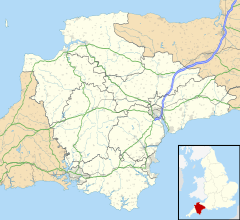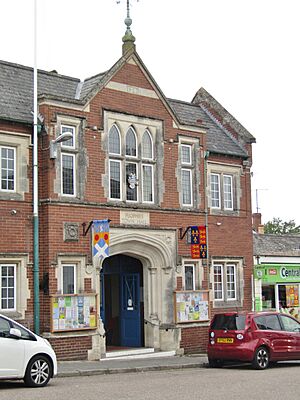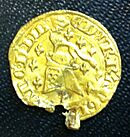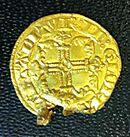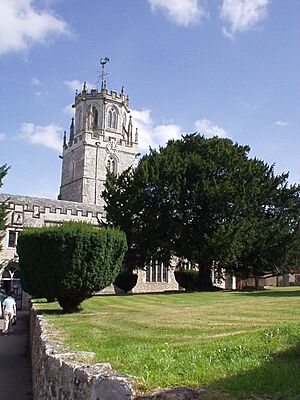Colyton, Devon facts for kids
Quick facts for kids Colyton |
|
|---|---|
 St. Andrew's church, with its octagonal lantern tower |
|
| Population | 2,105 (2011) |
| OS grid reference | SY245937 |
| Shire county | |
| Region | |
| Country | England |
| Sovereign state | United Kingdom |
| Post town | Colyton |
| Postcode district | EX24 |
| Dialling code | 01297 |
| Police | Devon and Cornwall |
| Fire | Devon and Somerset |
| Ambulance | South Western |
| EU Parliament | South West England |
| UK Parliament |
|
Colyton is a small town in Devon, England. It is located in the East Devon area. The River Coly flows right through the town. Colyton is about 3 miles (5 km) from Seaton and 6 miles (10 km) from Axminster. In 2011, about 2,105 people lived there. Colyton is an important part of the Coly Valley area.
Contents
What's in a Name?
The name Colyton was first written down in 964 as Culintona. People think the name comes from an old Celtic river name. It also includes the Old English word tun, which means "place" or "farmstead". So, Colyton likely means "farmstead by the River Coly".
Colyton's History
Colyton started as an old village around 700 AD. It was even mentioned in the Domesday Book as Culitone. This was a famous survey of England made in 1086. Around 945, King Edmund I made new laws in Colyton. These laws helped make society more stable. They focused on kings, lords, families, and communities.
Colyton grew into a key place for farming and trade. It had a mill for grinding corn and a saw mill. There was also an iron factory and a place to make leather from animal skins. This leather factory is still working today!
Near the town was Colcombe Castle. This castle belonged to the Courtenay family, who were important Earls of Devon. The castle is no longer standing.
After a powerful family member, Henry Courtenay, lost his lands, the Crown took them. But the people of Colyton bought some of these lands back for £1,000 in 1547. This led to the creation of the Feoffees of Colyton. These were local people who managed shared properties in the area. They still meet today at Colyton Town Hall.
Colyton has been called "the most rebellious town in Devon." This is because many people from Colyton joined the Monmouth Rebellion in 1685. This was a fight against King James II.
The Famous Church
The main church in Colyton is St Andrew's. It is a very old and important building. A Saxon church was once on this spot. But it was replaced by the current Norman church in the 11th century.
The church has a special octagonal (eight-sided) tower from the 14th century. It's called a lantern tower. Some say it was used as a light for ships on the River Axe. However, it's not clear if the tower could actually be seen from the river. The nearby house for the vicar, Brerewood House, is also very old. It dates back to about 1529.
Other Cool Things to See
Colyton Grammar School is a very old school, started in 1546. It used to be in a medieval building called the Old Church House. In 1927, the school moved to Colyford. This is a small village within the Colyton area.
The Seaton Tramway ends near Colyton, at Kingsdon. This tramway was once a regular train line. It connected Seaton, Colyford, and Colyton to a main train line. When the train line closed in 1966, a company bought part of it. They turned it into the Seaton Tramway in 1970. The tram line was slowly made longer. It reached Colyton in 1980. The old station building has been fixed up. It now has a ticket office, a gift shop, and a restaurant. The tramway is open for visitors most of the year.
In 2018, Colyton made news around the world! Someone complained anonymously about a resident hanging laundry outside. This made other residents and businesses hang underwear outside their own places. They did this to show support for the person who received the letter. In 2019, the town even held its first "Raising of the Pants" festival. It was a fun way to remember the event!
The town is also on the East Devon Way footpath. This is a walking path that goes through the beautiful East Devon area.
Getting Around Colyton
You can get to Colyton by bus. Bus service 885 connects Colyton to Beer and Axminster. The X30 bus goes to Seaton and Exeter.
The Seaton Tramway also comes to Colyton tram stop. While it's great for tourists, it's not usually used for everyday travel.
Historic Family Homes
Colyton parish is home to several historic estates:
- Great House: This was the home of the Yonge family.
- Shute: This was the home of the Pole family.
- Colcombe Castle: This was an old home of the Courtenay family. Later, it belonged to the Poles of Shute.
See also
 In Spanish: Colyton para niños
In Spanish: Colyton para niños


